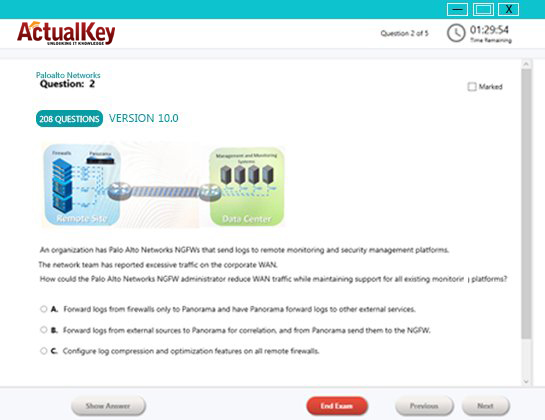Limited Time 30% Discount Offer Use Code - off30
Actualkey Prepration Latest 200-201 : Understanding Cisco Cybersecurity Operations Fundamentals (CBROPS) Exam Questions and Answers PDF's, Verified Answers via Experts - Pass Your Exam For Sure and instant Downloads - "Money Back Guarantee".
| Vendor | Cisco |
| Certification | Cisco Certified CyberOps Associate |
| Exam Code | 200-201 |
| Title | Understanding Cisco Cybersecurity Operations Fundamentals (CBROPS) Exam |
| No Of Questions | 430 |
| Last Updated | May 9,2024 |
| Product Type | Q & A with Explanations |
| Bundel Pack Included | PDF + Offline / Andriod Testing Engine and Simulator |
200-201 Understanding Cisco Cybersecurity Operations Fundamentals (CBROPS) Exam
Duration: 120 minutes
Languages: English
Associated certification : Cisco Certified CyberOps Associate
Exam overview
This exam tests your knowledge and skills related to:
Security concepts
Security monitoring
Host-based analysis
Network intrusion analysis
Security policies and procedures
Exam preparation
Official Cisco training
Understanding Cisco Cybersecurity Operations Fundamentals (CBROPS)
CBROPS training videos
CBROPS study materials
Understanding Cisco Cybersecurity Operations Fundamentals v1.0 (200-201)
Exam Description:
The Understanding Cisco Cybersecurity Operations Fundamentals (CBROPS) exam (200-201) is a 120-minute assessment that is associated with the Cisco Certified CyberOps Associate certification. The CBROPS exam tests a candidate’s knowledge and skills related to security concepts, security monitoring, host-based analysis, network intrusion analysis, and security policies and procedures. The course, Understanding Cisco Cybersecurity Operations Fundamentals, helps candidates to prepare for this exam.
The following topics are general guidelines for the content likely to be included on the exam. However, other related topics may also appear on any specific delivery of the exam. To better reflect the contents of the exam and for clarity purposes, the guidelines below may change at any time without notice.
20% 1.0 Security Concepts
1.1 Describe the CIA triad
1.2 Compare security deployments
1.2.a Network, endpoint, and application security systems
1.2.b Agentless and agent-based protections
1.2.c Legacy antivirus and antimalware
1.2.d SIEM, SOAR, and log management
1.3 Describe security terms
1.3.a Threat intelligence (TI)
1.3.b Threat hunting
1.3.c Malware analysis
1.3.d Threat actor
1.3.e Run book automation (RBA)
1.3.f Reverse engineering
1.3.g Sliding window anomaly detection
1.3.h Principle of least privilege
1.3.i Zero trust
1.3.j Threat intelligence platform (TIP)
1.4 Compare security concepts
1.4.a Risk (risk scoring/risk weighting, risk reduction, risk assessment)
1.4.b Threat
1.4.c Vulnerability
1.4.d Exploit
1.5 Describe the principles of the defense-in-depth strategy
1.6 Compare access control models
1.6.a Discretionary access control
1.6.b Mandatory access control
1.6.c Nondiscretionary access control
1.6.d Authentication, authorization, accounting
1.6.e Rule-based access control
1.6.f Time-based access control
1.6.g Role-based access control
1.7 Describe terms as defined in CVSS
1.7.a Attack vector
1.7.b Attack complexity
1.7.c Privileges required
1.7.d User interaction
1.7.e Scope
1.8 Identify the challenges of data visibility (network, host, and cloud) in detection
1.9 Identify potential data loss from provided traffic profiles
1.10 Interpret the 5-tuple approach to isolate a compromised host in a grouped set of logs
1.11 Compare rule-based detection vs. behavioral and statistical detection
25% 2.0 Security Monitoring
2.1 Compare attack surface and vulnerability
2.2 Identify the types of data provided by these technologies
2.2.a TCP dump
2.2.b NetFlow
2.2.c Next-gen firewall
2.2.d Traditional stateful firewall
2.2.e Application visibility and control
2.2.f Web content filtering
2.2.g Email content filtering
2.3 Describe the impact of these technologies on data visibility
2.3.a Access control list
2.3.b NAT/PAT
2.3.c Tunneling
2.3.d TOR
2.3.e Encryption
2.3.f P2P
2.3.g Encapsulation
2.3.h Load balancing
2.4 Describe the uses of these data types in security monitoring
2.4.a Full packet capture
2.4.b Session data
2.4.c Transaction data
2.4.d Statistical data
2.4.e Metadata
2.4.f Alert data
2.5 Describe network attacks, such as protocol-based, denial of service, distributed denial of service, and man-in-the-middle
2.6 Describe web application attacks, such as SQL injection, command injections, and crosssite scripting
2.7 Describe social engineering attacks
2.8 Describe endpoint-based attacks, such as buffer overflows, command and control (C2), malware, and ransomware
2.9 Describe evasion and obfuscation techniques, such as tunneling, encryption, and proxies
2.10 Describe the impact of certificates on security (includes PKI, public/private crossing the network, asymmetric/symmetric)
2.11 Identify the certificate components in a given scenario
2.11.a Cipher-suite
2.11.b X.509 certificates
2.11.c Key exchange
2.11.d Protocol version
2.11.e PKCS
20% 3.0 Host-Based Analysis
3.1 Describe the functionality of these endpoint technologies in regard to security monitoring
3.1.a Host-based intrusion detection
3.1.b Antimalware and antivirus
3.1.c Host-based firewall
3.1.d Application-level allow listing/block listing
3.1.e Systems-based sandboxing (such as Chrome, Java, Adobe Reader)
3.2 Identify components of an operating system (such as Windows and Linux) in a given scenario
3.3 Describe the role of attribution in an investigation
3.3.a Assets
3.3.b Threat actor
3.3.c Indicators of compromise
3.3.d Indicators of attack
3.3.e Chain of custody
3.4 Identify type of evidence used based on provided logs
3.4.a Best evidence
3.4.b Corroborative evidence
3.4.c Indirect evidence
3.5 Compare tampered and untampered disk image
3.6 Interpret operating system, application, or command line logs to identify an event
3.7 Interpret the output report of a malware analysis tool (such as a detonation chamber or sandbox)
3.7.a Hashes
3.7.b URLs
3.7.c Systems, events, and networking
20% 4.0 Network Intrusion Analysis
4.1 Map the provided events to source technologies
4.1.a IDS/IPS
4.1.b Firewall
4.1.c Network application control
4.1.d Proxy logs
4.1.e Antivirus
4.1.f Transaction data (NetFlow)
4.2 Compare impact and no impact for these items
4.2.a False positive
4.2.b False negative
4.2.c True positive
4.2.d True negative
4.2.e Benign
4.3 Compare deep packet inspection with packet filtering and stateful firewall operation
4.4 Compare inline traffic interrogation and taps or traffic monitoring
4.5 Compare the characteristics of data obtained from taps or traffic monitoring and transactional data (NetFlow) in the analysis of network traffic
4.6 Extract files from a TCP stream when given a PCAP file and Wireshark
4.7 Identify key elements in an intrusion from a given PCAP file
4.7.a Source address
4.7.b Destination address
4.7.c Source port
4.7.d Destination port
4.7.e Protocols
4.7.f Payloads
4.8 Interpret the fields in protocol headers as related to intrusion analysis
4.8.a Ethernet frame
4.8.b IPv4
4.8.c IPv6
4.8.d TCP
4.8.e UDP
4.8.f ICMP
4.8.g DNS
4.8.h SMTP/POP3/IMAP
4.8.i HTTP/HTTPS/HTTP2
4.8.j ARP
4.9 Interpret common artifact elements from an event to identify an alert
4.9.a IP address (source / destination)
4.9.b Client and server port identity
4.9.c Process (file or registry)
4.9.d System (API calls)
4.9.e Hashes
4.9.f URI / URL
4.10 Interpret basic regular expressions
15% 5.0 Security Policies and Procedures
5.1 Describe management concepts
5.1.a Asset management
5.1.b Configuration management
5.1.c Mobile device management
5.1.d Patch management
5.1.e Vulnerability management
5.2 Describe the elements in an incident response plan as stated in NIST.SP800-61
5.3 Apply the incident handling process (such as NIST.SP800-61) to an event
5.4 Map elements to these steps of analysis based on the NIST.SP800-61
5.4.a Preparation
5.4.b Detection and analysis
5.4.c Containment, eradication, and recovery
5.4.d Post-incident analysis (lessons learned)
5.5 Map the organization stakeholders against the NIST IR categories (CMMC, NIST.SP800-61)
5.5.a Preparation
5.5.b Detection and analysis
5.5.c Containment, eradication, and recovery
5.5.d Post-incident analysis (lessons learned)
5.6 Describe concepts as documented in NIST.SP800-86
5.6.a Evidence collection order
5.6.b Data integrity
5.6.c Data preservation
5.6.d Volatile data collection
5.7 Identify these elements used for network profiling
5.7.a Total throughput
5.7.b Session duration
5.7.c Ports used
5.7.d Critical asset address space
5.8 Identify these elements used for server profiling
5.8.a Listening ports
5.8.b Logged in users/service accounts
5.8.c Running processes
5.8.d Running tasks
5.8.e Applications
5.9 Identify protected data in a network
5.9.a PII
5.9.b PSI
5.9.c PHI
5.9.d Intellectual property
5.10 Classify intrusion events into categories as defined by security models, such as Cyber Kill Chain Model and Diamond Model of Intrusion
5.11 Describe the relationship of SOC metrics to scope analysis (time to detect, time to contain, time to respond, time to control)
QUESTION 1
Which event is user interaction?
A. gaining root access
B. executing remote code
C. reading and writing file permission
D. opening a malicious file
Correct Answer: D
QUESTION 2
Which security principle requires more than one person is required to perform a critical task?
A. least privilege
B. need to know
C. separation of duties
D. due diligence
Correct Answer: C
QUESTION 3
How is attacking a vulnerability categorized?
A. action on objectives
B. delivery
C. exploitation
D. installation
Correct Answer: C
QUESTION 4
What is a benefit of agent-based protection when compared to agentless protection?
A. It lowers maintenance costs
B. It provides a centralized platform
C. It collects and detects all traffic locally
D. It manages numerous devices simultaneously
Correct Answer: B
Section: Security Concepts
QUESTION 5
Which principle is being followed when an analyst gathers information relevant to a security incident to determine the appropriate course of action?
A. decision making
B. rapid response
C. data mining
D. due diligence
Correct Answer: A
QUESTION 6
One of the objectives of information security is to protect the CIA of information and systems.
What does CIA mean in this context?
A. confidentiality, identity, and authorization
B. confidentiality, integrity, and authorization
C. confidentiality, identity, and availability
D. confidentiality, integrity, and availability
Correct Answer: D
QUESTION 7
What is rule-based detection when compared to statistical detection?
A. proof of a user's identity
B. proof of a user's action
C. likelihood of user's action
D. falsification of a user's identity
Correct Answer: B
I Got My Success Due To Actualkey 200-201 Bundle Pack Actualkey experts I got passed in the 200-201 exam without any worries at all, these exam material products gave me the reason to relax.
Budi Saptarmat
Yahoo! Got Successfully Through The 200-201 Exam Passing Exam is not a easy thanks to Acutalkey.com for providing me actual 200-201 Understanding Cisco Cybersecurity Operations Fundamentals (CBROPS) Exam training with there included the Offline and Android simulators helps me success
Melinda
200-201 Exam Best Preparation I have been preparing for 200-201 Understanding Cisco Cybersecurity Operations Fundamentals (CBROPS) Exam, I was not sure that I'll be able to pass because of the fact that I am not a good student however;Actualkey.com provided me best and simple exam training pdf's and I passed. I now recommend everyone
Antonio Moreno
Actualkey.com 200-201 Offline Simulator is Best My choice to select Actualkey.com and go for the preparation 200-201 Understanding Cisco Cybersecurity Operations Fundamentals (CBROPS) Exam, because I got the short way with the easy way
Liliane Meichner
Actualkey.com 200-201 Exam PDF"s passed with in a week 200-201 exam pdf's that's amazing
James Wilson
Cisco - RELATED EXAMS
Implementing Cisco Unified Communications Manager Part 2 (CIPT2 v6.0)
Questions: 174 | May 8, 2024
Implementing Cisco Security Monitoring, Analysis andResponse System
Questions: 49 | May 8, 2024
Cisco Wide Area Application Services for System Engineers exam
Questions: 60 | August 1, 2024
Cisco Data Center Networking Infrastructure Solutions design
Questions: 120 | August 1, 2024
Implementing Cisco Unified Wireless Networking Essentials (IUWNE)
Questions: 203 | July 1, 2024
Associated Certifications: Cisco Storage Networking Support Specialist
Questions: 74 | August 1, 2024
Implementing Cisco Security Monitoring, Analysis, and Response System
Questions: 67 | August 1, 2024
Wide Area Application Services for System Engineers (WAASSE)
Questions: 90 | January 5, 2024
Implementing Advanced Cisco Unified Wireless Security (IAUWS)
Questions: 85 | January 7, 2024
Troubleshooting and Maintaining Cisco IP Switched Networks (TSHOOT)
Questions: 72 | January 7, 2024
Implementing Cisco Unified Communications Voice over IP and QoS v8.0 (CVOICE v8.0)
Questions: 257 | July 1, 2024
Securing Networks with Cisco Routers and Switches (SECURE) v1.0
Questions: 136 | July 1, 2024
Implementing Cisco Unified CommunicationsManager, Part 2 v8.0 (CIPT2 v8.0)
Questions: 215 | July 1, 2024
Introducing Cisco Voice and Unified Communications Administration v8.0
Questions: 300 | May 8, 2024
Integrating Cisco Unified Communications Applications v8.0 (CAPPS v8.0)
Questions: 203 | May 8, 2024
Operational Foundations for Cisco Service Provider Core Networks
Questions: 91 | May 8, 2024
Maintaining Cisco Service Provider VPNs and MPLS Networks (MSPVM)
Questions: 89 | May 8, 2024
Cisco Data Center Unified Computing Support Specialist Qualifier Exam (DCUCI Qualifier Exam)
Questions: 65 | May 8, 2024
Cisco Data Center Unified Computing Design Specialist Qualifier Exam
Questions: 62 | May 8, 2024
Designing for Cisco Internetwork Solutions Exam (DESGN) v2.1
Questions: 241 | October 1, 2024
Maintaining Cisco Service Provider Routing Protocols (MSPRP)
Questions: 70 | October 1, 2024
Maintaining Cisco Service Provider Quality of Service (MSPQS)
Questions: 91 | October 1, 2024
PSACAS Advanced Collaboration Architecture Sales Specialist Exam
Questions: 56 | May 8, 2024
PSACASE Advanced Collaboration Architecture System Engineer Exam
Questions: 64 | May 8, 2024
PSACAFE Advanced Collaboration Architecture Field Engineer Exam
Questions: 50 | August 1, 2024
Cisco IronPort Certified Security Professional (CICSP) Web Security 7.0
Questions: 66 | August 1, 2024
Implementing Cisco TelePresence Video Networking Solutions Exam
Questions: 57 | August 1, 2024
Advanced Borderless Network Architecture Systems Engineer Exam
Questions: 60 | August 1, 2024
Cisco Substation Automation System and Field Engineer Knowledge Verification
Questions: 58 | May 8, 2024
Authorized Connected Grid Account Manager Knowledge Verification
Questions: 23 | August 1, 2024
Cisco Data Center Unified Computing Systems Implementation (DCUCI)
Questions: 78 | May 8, 2024
Introduction to 802.1X Operations for Cisco Security Professionals Exam (S802DT1X)
Questions: 69 | May 8, 2024
Introducing Cisco Identity Services Engine for System Engineer Exam (PAISESE)
Questions: 34 | May 8, 2024
PASCERAM - Cisco SaaS Conferencing and EIM Resale ATP for the AM Exam
Questions: 35 | May 8, 2024
Cisco SP Video Wireline & Cable Headend Design Specialist for SE
Questions: 33 | May 8, 2024
PASCERSE - Cisco SaaS Conferencing and EIM Resale ATP for the SE Exam
Questions: 56 | May 8, 2024
Building Cisco Service Provider Next-Generation Networks, Part 2
Questions: 126 | May 8, 2024
Building Cisco Service Provider Next-Generation Networks, Part 1 Exam
Questions: 257 | October 25, 2024
Implementing Advanced Cisco Unified Wireless Security (IAUWS) v2.0
Questions: 206 | May 8, 2024
Deploying Cisco Service Provider Network Routing (SPROUTE)
Questions: 174 | January 12, 2024
Implementing Cisco Service Provider Next-Generation Core Network Services (SPCORE)
Questions: 184 | January 12, 2024
Implementing Cisco Service Provider Next-Generation Edge Network Services (SPEDGE) Exam
Questions: 185 | January 12, 2024
Implementing and Maintaining Cisco Technologies Using IOS XR - (IMTXR)
Questions: 77 | January 12, 2024
Designing and Implementing Cisco Unified Communications on Unified Computing Systems - DIUCUCS
Questions: 60 | January 12, 2024
Implementing and Configuring Cisco Identity Service Engine - SISE
Questions: 49 | July 1, 2024
PASCERFE - Cisco SaaS Conferencing and EIM Resale ATP for the FE Exam
Questions: 53 | July 1, 2024
Advanced Borderless Network Architecture Field Engineer Exam
Questions: 86 | January 15, 2024
Advanced Borderless Network Architecture Systems Engineer Exam (700-303)
Questions: 156 | January 15, 2024
Cisco Implementing Cisco Secure Mobility Solutions Exam (SIMOS)
Questions: 543 | May 17, 2024
Unified Communications Contact Center Express Implementation - UCCX
Questions: 50 | January 15, 2024
Performing Business-Focused Transformative Architecture Engagements
Questions: 67 | January 17, 2024
Configuring Cisco UCS and Cisco Catalyst 3000 for Vblock Series 100
Questions: 45 | January 17, 2024
Cisco Application Centric Infrastructure for System Engineers
Questions: 58 | January 17, 2024
Implementing Cisco Service Provider Mobile Unlicensed Small Cell Solutions
Questions: 51 | January 17, 2024
Securing Cisco Networks with Sourcefire Intrusion Prevention System
Questions: 59 | January 17, 2024
Implementing Cisco Service Provider Mobility UMTS Networks (SPUMTS)
Questions: 70 | January 17, 2024
Implementing Cisco Service Provider Mobility CDMA Networks (SPCDMA)
Questions: 70 | January 17, 2024
Implementing Cisco Service Provider Mobility LTE Networks (SPLTE)
Questions: 70 | January 17, 2024
Integrating Business Applications with Network Programmability (NPIBA)
Questions: 66 | January 17, 2024
Managing Industrial Networks with Cisco Networking Technologies (IMINS)
Questions: 64 | January 17, 2024
Designing with Cisco Network Programmability for ACI (NPDESACI)
Questions: 60 | January 17, 2024
Implementing with Cisco Network Programmability for ACI (NPENGACI)
Questions: 60 | January 17, 2024
Cisco Application Centric Infrastructure for Account Managers
Questions: 41 | January 17, 2024
Executing Cisco Advanced Business Value Analysis and Design Techniques
Questions: 60 | July 1, 2024
Troubleshooting and Maintaining Cisco IP Networks (TSHOOT)
Questions: 254/24Case Study | January 18, 2024
Cisco Application Centric Infrastructure for Field Engineers Exam
Questions: 50 | September 16, 2024
Implementing and Supporting Cisco Unified Contact Center Enterprise Exam
Questions: 95 | September 16, 2024
Executing Cisco Advanced Business Value Analysis and Design Techniques
Questions: 182 | September 16, 2024
Applying Cisco Specialized Business Value Analysis Skills
Questions: 173 | September 16, 2024
Cisco Implementing Cisco Wireless Network Fundamentals Exam
Questions: 509 | September 16, 2024
Managing Industrial Networks for Manufacturing with Cisco Technologies
Questions: 87 | September 16, 2024
Cisco Implementing and Troubleshooting the Cisco Cloud Infrastructure Exam
Questions: 132 | September 16, 2024
Building the Cisco Cloud with Application Centric Infrastructure
Questions: 60 | September 16, 2024
Cisco Leading Virtual Classroom Instruction - Written Exam
Questions: coming soon | September 16, 2024
Cisco Leading Virtual Classroom Instruction - Practical Exam
Questions: coming soon | September 16, 2024
Integrating Business Applications with Network Programmability
Questions: coming soon | January 19, 2024
Cisco Implementing Cisco Data Center Virtualization and Automation Exam
Questions: 167 | January 21, 2024
Cisco Midsize Collaboration Solutions for Account Managers (MCAM)
Questions: 30 | April 11, 2024
Cisco Data Center Unified Computing Infrastructure Design (DCICUC)
Questions: 40 | January 21, 2024
Cisco Enterprise Networks SDA, SDWAN and ISE Exam for System Engineers
Questions: 35 | January 21, 2024
Automating and Programming Cisco Security Solutions (SAUTO) Exam
Questions: 332 | May 9, 2024
Implementing and Operating Cisco Enterprise Network Core Technologies (ENCOR) Exam
Questions: 1172 | March 14, 2025
Implementing and Operating Cisco Data Center Core Technologies (DCCOR) Exam
Questions: 633 | May 10, 2024
Implementing Cisco Enterprise Advanced Routing and Services (ENARSI) Exam
Questions: 598 | March 14, 2025
Understanding Cisco Cybersecurity Operations Fundamentals (CBROPS) Exam
Questions: 430 | May 9, 2024
Designing Cisco Enterprise Wireless Networks (300-425 ENWLSD) Exam
Questions: 196 | November 8, 2024
Implementing Cisco Enterprise Wireless Networks (300-430 ENWLSI) Exam
Questions: 216 | November 8, 2024
Automating and Programming Cisco Enterprise Solutions (ENAUTO 300-435) Exam
Questions: 125 | November 8, 2024
Designing Cisco Data Center Infrastructure (300-610 DCID) Exam
Questions: 204 | November 8, 2024
Troubleshooting Cisco Data Center Infrastructure (300-615 DCIT) Exam
Questions: 517 | November 8, 2024
Implementing Cisco Application Centric Infrastructure (300-620 DCACI) Exam
Questions: 192 | November 8, 2024
Implementing Cisco Storage Area Networking (300-625 DCSAN) Exam
Questions: 60 | November 8, 2024
Securing Networks with Cisco Firepower (300-710 SNCF) Exam
Questions: 325 | November 8, 2024
Implementing and Configuring Cisco Identity Services Engine (300-715 SISE) Exam
Questions: 244 | November 8, 2024
Securing Email with Cisco Email Security Appliance (300-720 SESA) Exam
Questions: 147 | November 8, 2024
Securing the Web with Cisco Web Security Appliance (300-725 SWSA) Exam
Questions: 60 | November 8, 2024
Implementing Secure Solutions with Virtual Private Networks (SVPN 300-730) Exam
Questions: 175 | November 8, 2024
Implementing Cisco Collaboration Applications (300-810 CLICA) Exam
Questions: 213 | November 8, 2024
Implementing Cisco Advanced Call Control and Mobility Services (300-815 CLACCM) Exam
Questions: 174 | November 8, 2024
Implementing Cisco Collaboration Cloud and Edge Solutions (300-820 CLCEI)
Questions: 93 | November 8, 2024
Implementing DevOps Solutions and Practices using Cisco Platforms (300-910 DEVOPS) Exam
Questions: 130 | November 8, 2024
Developing Applications for Cisco Webex and Webex Devices (300-920 DEVWBX) Exam
Questions: 60 | November 8, 2024
Implementing and Operating Cisco Service Provider Network Core Technologies (350-501 SPCOR)
Questions: 452 | November 8, 2024
Implementing and Operating Cisco Security Core Technologies (SCOR 350-701) Exam
Questions: 633 | November 8, 2024
Implementing Cisco Collaboration Core Technologies (350-801 CLCOR) Exam
Questions: 273 | November 8, 2024
Developing Applications using Cisco Core Platforms and APIs v1.0 (DEVCOR 350-901) Exam
Questions: 363 | November 8, 2024
Designing Cisco Unified Contact Center Enterprise (UCCED) Exam
Questions: 93 | November 8, 2024
Implementing Cisco Application Centric Infrastructure - Advanced (600-660 - 300-630 DCACIA)
Questions: 76 | November 8, 2024
Supporting Cisco Routing and Switching Network Devices v3.0 - RSTECH Exam
Questions: 72 | November 8, 2024
Cisco Security Architecture for System Engineers (ASASE) Exam
Questions: 92 | November 8, 2024
Implementing Cisco Service Provider Advanced Routing Solutions (SPRI) Exam
Questions: 214 | November 8, 2024
Implementing Cisco Service Provider VPN Services (300-515 SPVI) Exam
Questions: 71 | November 8, 2024
Developing Solutions Using Cisco IoT and Edge Platforms (DEVIOT) Exam
Questions: 60 | November 8, 2024
Conducting Forensic Analysis and Incident Response Using Cisco CyberOps Technologies (CBRFIR) Exam
Questions: 59 | May 10, 2024
Performing CyberOps Using Core Security Technologies (CBRCOR) Exam
Questions: 139 | May 10, 2024
Implementing Cisco Collaboration Conferencing (CLCNF) Exam
Questions: 60 | September 16, 2024
Implementing Cisco SD-WAN Solutions (ENSDWI) Exam Corresponding Certification: CCNP Enterprise
Questions: 163 | September 16, 2024
Cisco Data Center Unified Computing Infrastructure Troubleshooting Exam
Questions: 40 | September 16, 2024
ENCOR Implementing and Operating Cisco Enterprise Network Core Technologies
Questions: 747 | May 10, 2024
Cisco Advanced Administration and Reporting of Contact Center Enterprise Exam
Questions: 60 | July 1, 2024
Cisco Certified Support Technician (CCST) Networking Exam
Questions: 40 | November 7, 2024
Cisco Collaboration SaaS Authorization for PreSales Engineer Exam
Questions: 60 | September 4, 2024
Exams code, certifications, vendor or keywords
![]()
Copyright © 2009 - 2025 Actualkey. All rights reserved.




